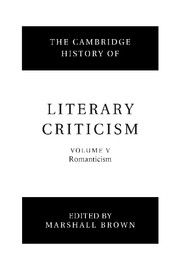Book contents
- Frontmatter
- Introduction
- 1 Classical standards in the period
- 2 Innovation and modernity
- 3 The French Revolution
- 4 Transcendental philosophy and Romantic criticism
- 5 Nature
- 6 Scientific models
- 7 Religion and literature
- 8 Language theory and the art of understanding
- 9 The transformation of rhetoric
- 10 Romantic irony
- 11 Theories of genre
- 12 Theory of the novel
- 13 The impact of Shakespeare
- 14 The vocation of criticism and the crisis of the republic of letters
- 15 Women, gender and literary criticism
- 16 Literary history and historicism
- 17 Literature and the other arts
- Bibliography
- Index
- References
1 - Classical standards in the period
Published online by Cambridge University Press: 28 March 2008
- Frontmatter
- Introduction
- 1 Classical standards in the period
- 2 Innovation and modernity
- 3 The French Revolution
- 4 Transcendental philosophy and Romantic criticism
- 5 Nature
- 6 Scientific models
- 7 Religion and literature
- 8 Language theory and the art of understanding
- 9 The transformation of rhetoric
- 10 Romantic irony
- 11 Theories of genre
- 12 Theory of the novel
- 13 The impact of Shakespeare
- 14 The vocation of criticism and the crisis of the republic of letters
- 15 Women, gender and literary criticism
- 16 Literary history and historicism
- 17 Literature and the other arts
- Bibliography
- Index
- References
Summary
If this topic should seem either too piecemeal or too self-evident to include in a general volume on romantic criticism, it may help to recall that for René Wellek the status of neoclassical criticism among the Romantics is the crucial issue that makes the second volume of his History of modern criticism possible: ‘I think we must recognize that we can speak of a general European Romantic movement only if we take a wide over-all view and consider simply the general rejection of the neoclassical creed as a common denominator.’ But possibly this claim only deepens suspicion. Arthur Lovejoy had famously argued that no criterion of any kind was common to all Romanticisms, and Wellek, who wrote his equally famous rebuttal of Lovejoy while at work on volume two, would have been especially eager at that time to uphold the legitimacy of broad period definitions. Can the exceptions, we may ask – Byron and Chateaubriand, for example – ever be acceptably rationalized from any standpoint, not just Lovejoy's?
Nevertheless, whatever one might feel moved to say on other occasions, this is clearly not the place for the postmodern insistence that only an atomism vastly exceeding even Lovejoy's can do justice to the complexity of literary history (and in any case, Musset had already said that about ‘Romanticism’ in 1824!). One must do what one can, aided in this case by the easily overlooked precision of Wellek's claim: we can try at first to agree, tentatively, that what the spirit of the Romantic age rejects is the neoclassical, not necessarily the Classical or the texts of antiquity, and proceed from there. It may finally be possible to show, however, that there is something even more telling, more truly characteristic and self-defining, albeit more varied, about the Romantic reception of Classical antiquity itself.
- Type
- Chapter
- Information
- The Cambridge History of Literary Criticism , pp. 7 - 28Publisher: Cambridge University PressPrint publication year: 2000
References
- 7
- Cited by

